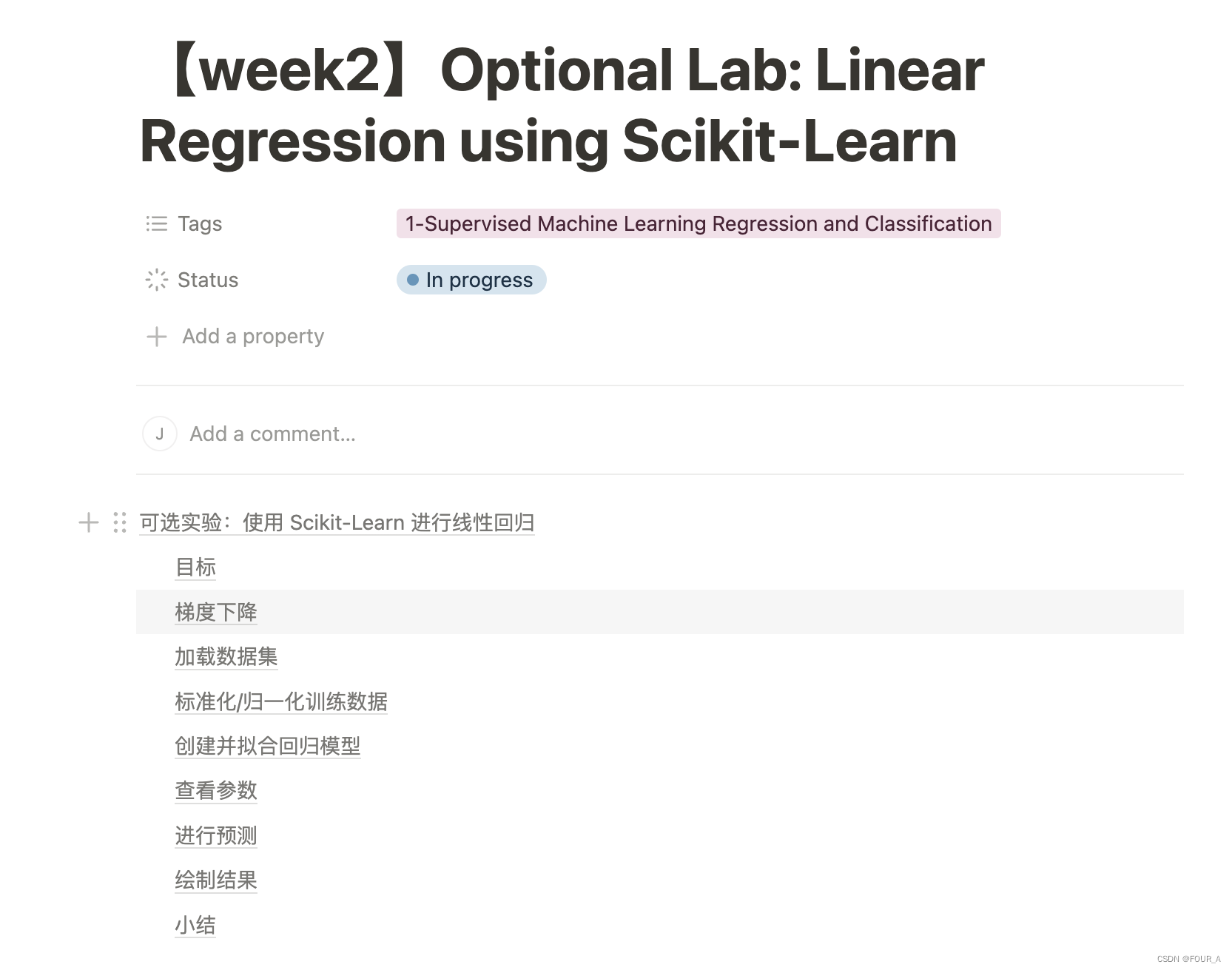支持我的工作 🎉
📃親愛的朋友們,感謝你們一直以來對我的關注和支持!
💪🏻 為了提供更優質的內容和更有趣的創作,我付出了大量的時間和精力。如果你覺得我的內容對你有幫助或帶來了歡樂,歡迎你通過打賞支持我的工作!🫰🏻你的一份打賞不僅是對我工作的認可,更是對我持續創作的巨大動力。無論金額多少,每一份支持都讓我倍感鼓舞和感激。
📝有關此篇文章的更多詳情請見:2022吳恩達機器學習Deeplearning.ai課程作業,給我一杯咖啡的支持吧!??
🔥再次感謝你們的支持和陪伴!
可選實驗:使用 Scikit-Learn 進行線性回歸
目標
在本實驗中,您將:
- 利用 scikit-learn 通過梯度下降實現線性回歸
import numpy as np
np.set_printoptions(precision=2) # 使其輸出的浮點數精度為小數點后兩位
# 這兩個類分別用于實現**普通線性回歸**和**使用隨機梯度下降法的線性回歸**
from sklearn.linear_model import LinearRegression, SGDRegressor
# 這個類用于**標準化數據**,使其均值為0,標準差為1。
from sklearn.preprocessing import StandardScaler
from lab_utils_multi import load_house_data
import matplotlib.pyplot as plt
dlblue = '#0096ff'; dlorange = '#FF9300'; dldarkred='#C00000'; dlmagenta='#FF40FF'; dlpurple='#7030A0';
plt.style.use('./deeplearning.mplstyle')
梯度下降
Scikit-learn 有一個梯度下降回歸模型 sklearn.linear_model.SGDRegressor。與您之前的梯度下降實現類似,該模型在標準化輸入下表現最佳。sklearn.preprocessing.StandardScaler 將執行 z-score 標準化,如之前的實驗中所示。在這里,它被稱為“標準分數”。
加載數據集
X_train, y_train = load_house_data()
X_features = ['size(sqft)','bedrooms','floors','age']
標準化/歸一化訓練數據
scaler = StandardScaler()
X_norm = scaler.fit_transform(X_train)
print(f"Peak to Peak range by column in Raw X:{np.ptp(X_train,axis=0)}")
print(f"Peak to Peak range by column in Normalized X:{np.ptp(X_norm,axis=0)}")## print
Peak to Peak range by column in Raw X:[2.41e+03 4.00e+00 1.00e+00 9.50e+01]
Peak to Peak range by column in Normalized X:[5.85 6.14 2.06 3.69]
scaler = StandardScaler()- 創建一個
StandardScaler實例 StandardScaler是scikit-learn提供的一個類,用于數據標準化。標準化的目的是使數據具有零均值和單位方差
- 創建一個
X_norm = scaler.fit_transform(X_train)- 使用
StandardScaler實例對X_train數據進行標準化。 fit_transform方法首先計算數據的均值和標準差,然后對數據進行標準化。- 返回的
X_norm是標準化后的數據。
- 使用
print(f"Peak to Peak range by column in Raw X:{np.ptp(X_train,axis=0)}")- 計算并打印原始數據
X_train每一列的峰值范圍(最大值減去最小值)。 np.ptp函數用于計算沿指定軸的峰值范圍,這里使用axis=0表示按列計算。
- 計算并打印原始數據
print(f"Peak to Peak range by column in Normalized X:{np.ptp(X_norm,axis=0)}")- 計算并打印標準化后數據
X_norm每一列的峰值范圍。 - 標準化后的數據通常會有較小且相似的范圍,因為它們被縮放到相同的尺度。
- 計算并打印標準化后數據
創建并擬合回歸模型
## 創建 SGDRegressor 實例
sgdr = SGDRegressor(max_iter=1000)## 訓練模型
sgdr.fit(X_norm, y_train)print(sgdr). # 打印 SGDRegressor 模型的**概述信息**,顯示**模型的主要參數和設置**## 打印迭代次數和權重更新次數
print(f"number of iterations completed: {sgdr.n_iter_}, number of weight updates: {sgdr.t_}")## print
SGDRegressor()
number of iterations completed: 117, number of weight updates: 11584.0
-
sgdr = SGDRegressor(max_iter=1000)創建一個
SGDRegressor實例,并將最大迭代次數設置為 1000。SGDRegressor是scikit-learn提供的一種使用隨機梯度下降法訓練線性模型的回歸器。 -
sgdr.fit(X_norm, y_train)- 使用標準化后的訓練數據
X_norm和目標變量y_train來訓練SGDRegressor模型。 fit方法用于擬合模型。
- 使用標準化后的訓練數據
查看參數
請注意,這些參數與標準化輸入數據相關。擬合參數與之前實驗中使用該數據找到的參數非常接近。
# 獲取 SGDRegressor 模型的截距(偏置項)。intercept_ 屬性包含模型的截距
b_norm = sgdr.intercept_ # 獲取 SGDRegressor 模型的系數(權重)。coef_ 屬性包含模型的系數
w_norm = sgdr.coef_
print(f"model parameters: w: {w_norm}, b:{b_norm}")
print(f"model parameters from previous lab: w: [110.56 -21.27 -32.71 -37.97], b: 363.16")## print
model parameters: w: [110.08 -21.05 -32.46 -38.04], b:[363.15]
model parameters from previous lab: w: [110.56 -21.27 -32.71 -37.97], b: 363.16
進行預測
預測訓練數據的目標值。使用 predict 例程,并使用 w w w 和 b b b 進行計算。
# 使用 sgdr.predict() 進行預測
y_pred_sgd = sgdr.predict(X_norm)
# 使用權重和截距進行預測
y_pred = np.dot(X_norm, w_norm) + b_norm
# 檢查所有預測值是否都相同,如果相同則返回 True,否則返回 False。
print(f"prediction using np.dot() and sgdr.predict match: {(y_pred == y_pred_sgd).all()}")# 打印前四個樣本的預測值和目標值進行對比
print(f"Prediction on training set:\n{y_pred[:4]}" )
print(f"Target values \n{y_train[:4]}")## print
prediction using np.dot() and sgdr.predict match: True
Prediction on training set:[295.2 485.82 389.56 491.98]
Target values [300. 509.8 394. 540. ]
y_pred_sgd = sgdr.predict(X_norm)- 使用訓練好的
SGDRegressor模型對標準化后的數據X_norm進行預測。 predict方法會根據模型的系數和截距計算預測值。
- 使用訓練好的
y_pred = np.dot(X_norm, w_norm) + b_norm- 直接使用之前獲取的權重
w_norm和截距b_norm對標- 準化后的數據X_norm進行預測。 np.dot(X_norm, w_norm)計算每個樣本的線性組合,加上截距b_norm得到預測值。
- 直接使用之前獲取的權重
繪制結果
讓我們繪制預測值與目標值的對比圖。
# plot predictions and targets vs original features
fig,ax=plt.subplots(1,4,figsize=(12,3),sharey=True)
for i in range(len(ax)):ax[i].scatter(X_train[:,i],y_train, label = 'target') # 繪制實際值的散點圖ax[i].set_xlabel(X_features[i])ax[i].scatter(X_train[:,i],y_pred,color=dlorange, label = 'predict') # 繪制預測值的散點圖
ax[0].set_ylabel("Price");
ax[0].legend();
fig.suptitle("target versus prediction using z-score normalized model")
plt.show()

小結
- 使用開源機器學習工具包 scikit-learn:
- scikit-learn 是一個使用的機器學習庫,提供了各種算法和工具,用于數據預處理、模型訓練和評估。
- 實現了線性回歸模型:
- 通過使用梯度下降算法(SGDRegressor),我們訓練了一個線性回歸模型來預測房價。
- 我們還使用了**標準化技術(StandardScaler)**對特征數據進行了歸一化處理,從而加快了模型的收斂速度并提高了模型的性能。

-實體與設計關系)





![[pwn]靜態編譯](http://pic.xiahunao.cn/[pwn]靜態編譯)
建設)









)

